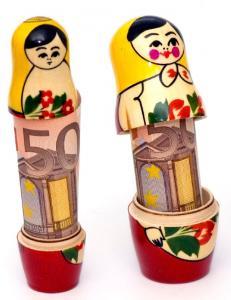Inside Out: Business in Russia

By Teagan Miller
J@pan Inc’s column concerning business conditions in an emerging market
When Toyota Vice President, Tokuichi Uranishi, addressed a press conference in Seoul, March 2008, his forecast noted that the rising prices of raw materials and a slump in demand from the US has led the company to emerging markets such as India, China and Russia to reach their 2008 global sales targets. As the credit crunch intensifies throughout world markets, investors are intensifying their focus on the world’s emerging markets for their investments and business development strategies. Emerging markets account for more than 30% of the global economy; their land mass is multiple times larger than even the whole of developed Europe; and they have demography on their side—populations in emerging markets are forecasted to grow by one billion by 2050, while populations of developed nations are predicted to decline.

The bear
A recent Morgan Stanley report ranked Russia as the “top emerging market” based on rising oil prices and a forecasted increase in GDP for 2008 to 6.7%, up from 6% in February. The report stated, “Russia will remain well insulated from the current global growth slowdown and domestic demand should remain strong.” So why is the Russian market predicted to be so profitable?
Russia is currently in the ninth straight year of annual growth, averaging an increase of 7% annually. In 2007, the GDP was US$2.06-7 trillion, the seventh highest in the world, and surprisingly non-traded services and goods for the increasingly wealthy domestic market are spurning this growth. Still, for a country claiming over one eighth of world’s land, so large it covers 11 time zones, natural resources undoubtedly provide a solid economic grounding. Home to the world’s largest natural gas reserves, the second largest coal reserves, and the eighth largest oil reserves, oil, gas, metals and timber account for 80% of exports, but this figure only contributes to 5.7% of the GDP. Clearly, there is a good deal to be gained from the domestic market, and this is why many foreign corporations are increasingly trying to muscle in.
Troika Diolog, the Russian investment bank, calculated that some 60% of the Russian population has a disposable income of over US$350 a household. With the number of households predicted to reach 85 million by the end of this year— that’s more than the population of Germany. Thus, sectors such as retail banking are proving popular targets for a number of global financial institutions; HSBC announced in March this year that it intends to invest US$200 million in Russian operations. Around the same time, Japan’s Mizuho announced its establishment of a presence in Moscow, having last year acquired Michinoku—the only Japanese bank licensed to operate in the country.

In other retail markets, boom times are set to continue as investment from domestic and overseas manufacturers has led to an unprecedented growth in the retail and development of Russian fast-moving consumer goods (FMCG)—Pepsi has just announced it will be a majority stake-holder in the juice company JSC Lebedyansky. Meanwhile, Coca-Cola had already cornered Russia’s carbonated drinks market in 2005. Russia’s beer and juice consumption is expected to become the largest in Europe by the end of the year, and for coffee, it already is. Ultimately, food plays the dominant role in the consumer market at 74% whilst other products show impressive growth rates such as pet foods, which have been expanding at 15% a year.
Motoring and the telecommunications markets are also looking promising for foreign speculators—Nortel has for some years been working hard to create wireless, and fixed cable operations across Russia, and Nokia was reportedly unable to produce enough mobile handsets for the 2008 New Year demand. Analysts tend to agree that there is still untapped potential in tourism, financial products and durables such as furniture and electronics. Dmitry Vinogradov, a Russian analyst for Citigroup summed up this positive sentiment in a recent paper published by their Equity Research group asking, “Credit crunch, what credit crunch?”
All that glitters…
Russia is not, however, an unbridled land of possibility for investors. The Economist lists the country as a “high risk” political zone, citing opposition to foreign investment and “the expropriation of assets in the oil industry” as dangers. The oil industry has been highly controversial with the government forcing foreign players to take smaller and smaller stakes in projects in favor of state backed entities such as Gazprom. Royal Dutch Shell, Mitsui and Mitsubishi learned this the hard way when the Russian government suddenly pulled environmental approval from the Sakhalin 2 oil and gas mining project in 2006. Additionally, for some, the Russian economy remains closely tied to global oil prices and could face a dramatic upset should prices plunge.
Furthermore, while the Russian market is reaching a new age of expansion, state policies remain in the Dark Ages. In their Economic Survey of the Russian Federation, 2006, the Organization for Economic Co-operation and Development (OECD) criticizes the country’s government as being “inefficient, largely unresponsive to either the public or its political masters, and often corrupt.” Structural reforms become near impossible under such an administration and bureaucratic problems plaguing investors remain unsolved. The report also notes Russia’s growing state ownership as being a “step back,” hindering the development of both companies and their markets.
The question also remains of how long the consumer boom will continue and while Putin has kept a firm grip on stability, there is a definite period of change on the horizon despite the ostensibly smooth transition to Medvedev, who is also the Chairman of the board of Gazprom.
For now however, Russia stands strong as FDI and consumer spending generate cyclonic growth. And, while the risk is high, even such shady corporations as Gazprom are free of limitation in terms of foreign investment— in theory, anyone is welcome to take a stake.
In such ambivalent conditions, decisions on the Russia market should be highly sensitive to context—the nature of the specific market, geographical location and likelihood of government or regulatory interventions.





